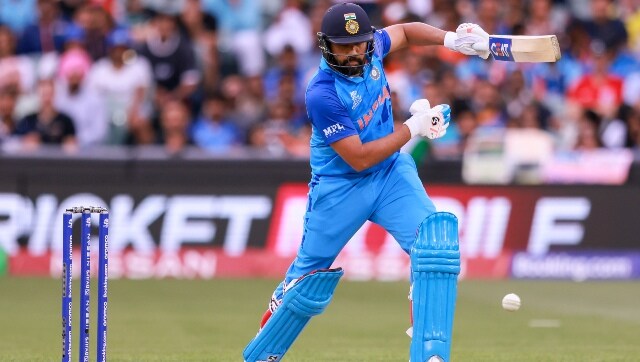T20 World Cup: India’s much-talked ‘fearless intent’ proves to be a sham

‘Attack brand of cricket’, ‘fearless approach’, ‘intent’ – these are the words fans have been hearing from the Indian cricket team and management ever since Rohit Sharma and Rahul Dravid took charge. But those words seemed merely theoretical throughout the T20 World Cup. Instead, the overused phrases in the last couple of weeks were: ‘tacky conditions’, ‘swinging conditions’, ‘bouncy tracks’, and ‘adapting to conditions’.
T20 World Cup: Full coverage | Schedule | Results | Points Table | News | Photos
As India lost to England in the semi-final at Adelaide, it was easier to blame the bowlers for failing to take wickets, but the reality was in admitting that the team were at least 20 runs short to build scoreboard pressure.
T20 World Cup: Full coverage | Schedule | Results | Points Table | News | Photos
“At that 15-over mark, we felt we were probably 15-20 short… In the end, it looked like we were a lot shorter than even 15-20. [But] I think we should have been able to get to 180-185 on that wicket.” Dravid admitted in the post-match presser, but that would not give India a second shot at the elusive trophy.
Since the death overs produced runs at more than 14 runs per over against England, the powerplay and the middle overs have to be blamed. But that phase cannot be blamed only in the semi-final, as that had been the trend from the beginning of the T20 World Cup.
Analysis: India fall short in planning, execution, and courage against England in the semi-final
India had scores of 31/3 (vs Pakistan), 32/1 (vs Netherlands), 33/2 (vs South Africa), 37/1 (vs Bangladesh), 46/1 (vs Zimbabwe), and 38/1 (vs England) in the powerplay this tournament.
To add to that, India scored at 6 runs per over in the powerplay in the T20 World Cup. This increased to 8.1 runs in the middle overs and 11.9 runs in the last five overs.
Subsequent to the 2021 World Cup debacle, and prior to this World Cup, when India had committed to the new batting philosophy, India scored at 8.6 in the powerplay, 8.9 in the middle overs, and 11.1 in the death overs.
If this is not sufficient, India’s scoring rate in the powerplay in this World Cup has been better than only UAE.
The stats show that just like modern-day dating, India freely flirted with attacking philosophy, but failed to make a commitment when asked for. Probably, they saw a few red flags with the approach. India went conservative with their batting, while conservatism was supposed to be shown only in being committed and loyal to the betrothed philosophy.
Since 2021 World Cup India have shown more intent in bilaterals but it’s dropped off in this comp. This is generally the case for all teams but in this comp only the UAE scored more slowly in the Powerplay than India & only Afg, Ned, SL & UAE attacked less overall. #T20WorldCup pic.twitter.com/YmgJz6VH9F
— Freddie Wilde (@fwildecricket) November 10, 2022
If we further bisect the trend, the two openers were the prime culprit and partnered in the crime. India’s run rate with the opening pair at the crease was the lowest in the Super 12 stage and higher only than Namibia throughout the World Cup.
Virat Kohli either is nowhere in the top-10 batters in terms of strike rate, but it will be largely unfair to make him stand in the dock as he was the only one to hold the Indian innings in each match.
Suryakumar Yadav was the only Indian batter to follow the aforementioned approaches without any hesitation. He took the onus to pull India out of nervy situations in the league stage, but India faltered to do that once he failed in the semi-final even after Hardik Pandya’s death over blitz.
The conditions were a factor in determining the batting approach, and Dravid had earlier said that his batters would adapt to score 180/190 if such a pitch comes across their way. And such a pitch did come their way in the semi-final, but they couldn’t adapt.
India wanted to bat first if they had won the toss, and they got to do that even after they lost the toss. Teams winning the toss had failed to win any of the games in Adelaide. A win-win of sorts for Rohit Sharma, but only momentary.
Batting first was something India had tried hard to accommodate to, pursuing themselves to bat first even in tricky conditions and looking for scoreboard pressure on the opposition, in the follow-up to the World Cup. They also boasted 17 wins from 24 games, batting first this year. But the pressure mounted at a crucial juncture in the tournament.
With the intent and fearlessness with which the English opening duo batted, even those 20 additional runs might have felt shorter, the only positive India would have had was stretching the match to the 18th over instead of the 16th.
While the change in the batting philosophy is the actual need of the hour, the question that arises is will India continue with the same set of batters and ask them to change the approach or a new line-up will be built in two years’ time.
Read all the Latest News, Trending News, Cricket News, Bollywood News, India News and Entertainment News here. Follow us on Facebook, Twitter and Instagram.
For all the latest Sports News Click Here
For the latest news and updates, follow us on Google News.

